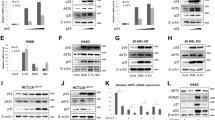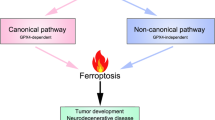Abstract
The tumor suppressor p53 accumulates under diverse stress conditions and affects cell cycle progression and/or apoptosis. This has been exemplified for endogenously produced or exogenously supplied nitric oxide (NO) and thus accounts at least in part for pathophysiological signaling of that bioactive molecule, although detailed mechanisms remain to be elucidated. By using luciferase reporter assays, we show that NO stabilized a transcriptionally active p53 protein. Considering that p53 is targeted by murine double minute (Mdm2) for ubiquitination and subsequent proteasomal degradation and knowing that this interaction is impaired by, for example, UV-treatment with concomitant stabilization of p53 we questioned the p53/Mdm2 interaction in the presence of NO. Although p53 became phosphorylated at serine 15 under the impact of NO, coimmunoprecipitation with Mdm2 and ubiquitination remained intact, thus excluding any interference of NO with this pathway. The importance of N-terminal p53 phosphorylation was verified with p53 mutants where the first six serine residues have been converted to alanine, and which do not accumulate in response to NO. Regulation of p53 stability can be also achieved by affecting nuclear–cytoplasmic shuttling and it was presented that leptomycin B, an inhibitor of nuclear export, caused p53 accumulation. Cell fractionation and immunofluorescence staining following NO-treatment revealed predominant nuclear accumulation of p53 in close association with serine 15-phosphorylation, which suggests impaired nuclear–cytoplasmic shuttling. This was verified by heterokaryon analysis. We conclude that attenuated nuclear export contributes to stabilization and activation of p53 under the influence of NO.
This is a preview of subscription content, access via your institution
Access options
Subscribe to this journal
Receive 50 print issues and online access
$259.00 per year
only $5.18 per issue
Buy this article
- Purchase on Springer Link
- Instant access to full article PDF
Prices may be subject to local taxes which are calculated during checkout





Similar content being viewed by others
Abbreviations
- NO:
-
nitric oxide
- GSNO:
-
S-nitrosoglutathione
- SpNO:
-
spermine-NONOate
- DAPI:
-
4′,6-diamino-2-phenylindole
- CRM1:
-
chromosome region maintenance 1
- Mdm2:
-
murine double minute
- NES:
-
nuclear export sequence
References
Barak Y, Juven T, Haffner R and Oren M . (1993). EMBO J., 12, 461–468.
Berendji D, Kolb-Bachofen V, Meyer KL, Grapenthin O, Weber H, Wahn V and Kroncke KD . (1997). FEBS Lett., 405, 37–41.
Boyd SD, Tsai KY and Jacks T . (2000). Nat. Cell Biol., 2, 563–568.
Brüne B, von Knethen A and Sandau KB . (1999). Cell Death Differ., 6, 969–975.
Brüne B, von Knethen A and Sandau KB . (2001). Cell. Signal., 13, 25–33.
Callsen D and Brüne B . (1999). Biochemistry, 38, 2279–2286.
Chen J, Lin J and Levine AJ . (1995). Mol. Med., 1, 142–152.
Chen J, Wu X, Lin J and Levine AJ . (1996). Mol. Cell. Biol., 16, 2445–2452.
Davis DW, Weidner DA, Holian A and McConkey DJ . (2000). J. Exp. Med., 192, 857–869.
Dumaz N and Meek DW . (1999). EMBO J., 18, 7002–7010.
El-Deiry WS, Tokino T, Velculescu VE, Levy DB, Parsons R, Trent JM, Lin D, Mercer WE, Kinzler KW and Vogelstein B . (1993). Cell, 75, 817–825.
Fornerod M, Ohno M, Yoshida M and Mattaj IW . (1997). Cell, 90, 1051–1060.
Forrester K, Ambs S, Lupold SE, Kapust RB, Spillare EA, Weinberg WC, Felley-Bosco E, Wang XW, Geller DA, Tzeng E, Billiar TR and Harris CC . (1996). Proc. Natl. Acad. Sci. USA, 93, 2442–2447.
Fuchs SY, Adler V, Buschmann T, Wu X and Ronai Z . (1998). Oncogene, 17, 2543–2547.
Fukuda M, Asano S, Nakamura T, Adachi M, Yoshida M, Yanagida M and Nishida E . (1997). Nature, 390, 308–311.
Geyer RK, Yu ZK and Maki CG . (2000). Nat. Cell Biol., 2, 569–573.
Gottifredi V and Prives C . (2001). Science, 292, 1851–1852.
Gu W and Roeder RG . (1997). Cell, 90, 595–606.
Hart TW . (1985). Tetrahedron Lett., 26, 2013–2016.
Haupt Y, Maya R, Kazaz A and Oren M . (1997). Nature, 387, 296–299.
Hengstermann A, Whitaker NJ, Zimmer D, Zentgraf H and Scheffher M . (1998). Oncogene, 17, 2933–2941.
Hirao A, Kong YY, Matsuoka S, Wakeham A, Ruland J, Yoshida H, Liu D, Elledge SJ and Mak TW (2000). Science, 287, 1824–1827.
Honda R, Tanaka H and Yasuda H . (1997). FEBS Lett., 420, 25–27.
Kern SE, Pietenpol JA, Thiagalingam S, Seymour A, Kinzler KW and Vogelstein B . (1992). Science, 256, 827–830.
Kim SJ, Hwang SG, Shin DY, Kang SS and Chan JS . (2002). J. Biol. Chem., 277, 33501–33508.
Kroncke KD, Fehsel K, Schmidt T, Zenke FT, Dasting I, Wesener JR, Bettermann H, Breunig KD and Kolb-Bachofen V . (1994). Biochem. Biophys. Res. Commun., 200, 1105–1110.
Kubbutat MH, Jones SN and Vousden KH . (1997). Nature, 387, 299–303.
Kubbutat MH, Ludwig RL, Ashcroft M and Vousden KH . (1998). Mol. Cell. Biol., 18, 5690–5698.
Kudo N, Wolff B, Sekimoto T, Schreiner EP, Yoneda Y, Yanagida M, Horinouchi S and Yoshida M . (1998). Exp. Cell Res., 242, 540–547.
Liang and Clarke MF . (2001). Eur. J. Biochem., 268, 2779–2783.
Lopes UG, Erhardt P, Yao R and Cooper GM . (1997). J. Biol. Chem., 272, 12893–12896.
Maki CG, Huibregtse JM and Howley PM . (1996). Cancer Res., 56, 2649–2654.
Maki CG . (1999). J. Biol. Chem., 274, 16531–16535.
Marin MC, Jost CA, Irwin MS, DeCaprio JA, Caput D and, Kaelin Jr WG . (1998). Mol. Cell. Biol., 18, 6316–6324.
Matsuoka M and Igisu H . (2001) Biochem. Biophys. Res. Commun., 282, 1120–1125.
Meek DW . (1998). Cell. Signal., 10, 159–166.
Messmer UK, Ankarcrona M, Nicotera P and Brüne B . (1994). FEBS Lett., 355, 23–26.
Messmer UK and Brüne B . (1996). Biochem. J., 319, 299–305.
Miyashita T and Reed JC . (1995). Cell, 80, 293–299.
Nakaya N, Lowe SW, Taya Y, Chenchik A and Enikolopov G . (2000). Oncogene, 19, 6369–6375.
Oliner JD, Kinzler KW, Meltzer PS, George DL and Vogelstein B . (1992). Nature, 358, 80–83.
Ossareh-Nazari B, Bachelerie F and Dargemont C . (1997). Science, 278, 141–144.
Pise-Masison CA, Radonovich M, Sakaguchi K, Appella E and Brady JN . (1998). J. Virol., 72, 6348–6355.
Roth J, Dobbelstein M, Freedman DA, Shenk T and Levine AJ . (1998). EMBO J., 17, 554–564.
Shaw P, Freeman J, Bovey R and Iggo R . (1996). Oncogene, 12, 921–930.
Shieh SY, Ikeda M, Taya Y and Prives C . (1997). Cell, 91, 325–334.
Siliciano JD, Canman CE, Taya Y, Sakaguchi K, Appella E and Kastan MB . (1997). Genes Dev., 11, 3471–3481.
Stamler JS, Simon DI, Osborne JA, Mullins ME, Jaraki O, Michel T, Singel DJ and Loscalzo J . (1992). Proc. Natl. Acad. Sci. USA, 89, 444–448.
Stommel JM, Marchenko ND, Jimenez GS, Moll UM, Hope TJ and Wahl GM . (1999). EMBO J., 18, 1660–1672.
Tao W and Levine AJ . (1999a). Proc. Natl. Acad. Sci. USA, 96, 3077–3080.
Tao W and Levine AJ . (1999b). Proc. Natl. Acad. Sci. USA, 96, 6937–6941.
Treier M, Staszewski LM and Bohmann D . (1994). Cell, 78, 787–798.
Turenne GA, Paul P, Laflair L and Price BD . (2001). Oncogene, 20, 5100–5110.
Wang X, Michael D, de Murcia G and Oren M . (2002). J. Biol. Chem., 277, 15697–15702.
Wu X, Bayle JH, Olson D and Levine AJ . (1993). Genes Dev., 7, 1126–1132.
Yang F, von Knethen A and Brüne B . (2000). J. Leukoc. Biol., 68, 916–922.
Zhang Y and Xiong Y . (2001a). Cell Growth Differ., 12, 175–186.
Zhang Y and Xiong Y . (2001b). Science, 292, 1910–1915.
Acknowledgements
We thank M Decker and B Rogge for technical assistance. Thanks go to B Vogelstein for providing p53 reporter plasmids, D Bohmann for providing the His-ubiquitin expression plasmid, C Jost for providing the HA-p53 construct and K. Vousden as well as J Chen for providing the Mdm2 construct and M Scheffner for providing p53 Δ62–96 and p53 Δ62–96 S>A plasmids. We also thank M Yoshida for his generous gift of LMB. This work was supported by the Deutsche Forschungsgemeinschaft (BR999), Wilhelm Sander-Foundation and Boehringer Ingelheim Fonds for a travel award to NS.
Author information
Authors and Affiliations
Corresponding author
Rights and permissions
About this article
Cite this article
Schneiderhan, N., Budde, A., Zhang, Y. et al. Nitric oxide induces phosphorylation of p53 and impairs nuclear export. Oncogene 22, 2857–2868 (2003). https://doi.org/10.1038/sj.onc.1206431
Received:
Revised:
Accepted:
Published:
Issue Date:
DOI: https://doi.org/10.1038/sj.onc.1206431
Keywords
This article is cited by
-
TRIM72 promotes alveolar epithelial cell membrane repair and ameliorates lung fibrosis
Respiratory Research (2020)
-
Activation of the steroid and xenobiotic receptor, SXR, induces apoptosis in breast cancer cells
BMC Cancer (2009)
-
A high-content chemical screen identifies ellipticine as a modulator of p53 nuclear localization
Apoptosis (2008)
-
Specific protein nitration in nitric oxide-induced apoptosis of human monocytes
Apoptosis (2008)
-
Nerve Growth Factor Potentiates p53 DNA Binding but Inhibits Nitric Oxide-Induced Apoptosis in Neuronal PC12 Cells
Neurochemical Research (2007)



